
Xiang Yi, graduated from Henan University majoring in museology, and postgraduate of Inner Mongolia Normal University, with a master degree in historical philology. Museologist of the Research Department of Henan Museum.
This bronze he vessel features a wild-goose-shaped body. The wild goose raises its neck upwards and holds its head high, its eyes wide open and bill slightly open to form the vessel’s spout. The loop handle at the wild goose’s tail is shaped like a curved dragon. The vessel is supported by four cylindrical feet underneath the flat belly. The mouth features a circle of rim. In the center of the lid there is a knob, thicker on the top and thinner at the bottom. It is connected to the vessel with a chain shaped like a human, standing on the wild goose’s tail and made with round sculpture technique. The he vessel looks elegant with delicate craftsmanship.
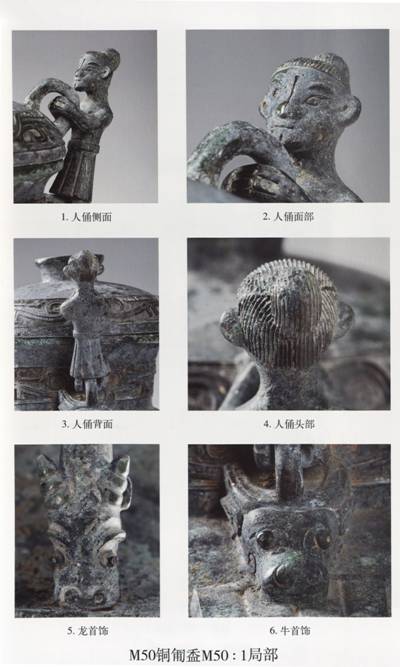
The Pu’s bronze he vessel M50:1 (Part)
1. Human figurine’s profile
2. Human figurine’s face
3. Human figurine’s back
4. Human figurine’s head
5. Dragon-head ornament
6. Ox-head ornament
There is an inscription consisting of 44 characters in five lines inside the lid: On the day of Wushen in the first half of the fourth lunar month, an envoy named Pu sent by Ying State went to Xing State in present-day Hebei for a diplomatic visit. As Pu’s visit drew to the end, Duke Qing asked Mao, the court official in charge of foreign affairs, to present Pu some farewell gifts, namely 15 kilograms of copper, one deerskin gown and one leather apron. Pu had this bronze he vessel cast with the copper in commemoration of his successful visit to Xing State and to be used forever.
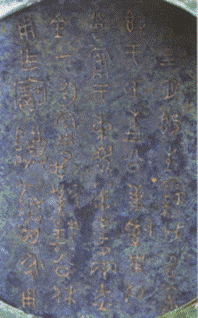
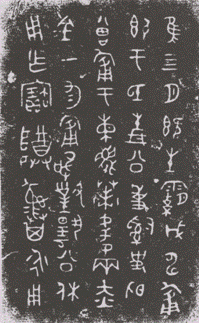
Inscription inside the lid Rubbing of the inscription
The academic circles, however, still hold different opinions on the historical fact described in the inscription: Whether it was a diplomatic visit by an envoy of the Zhou court to a vassal state, or a diplomatic exchange between vassal states? The main question lies in the identity of Duke Qing in the inscription. According to some scholars, including Wang Longzheng who participated in the excavation of Ying State cemetery [2], Duke Qing is Duke Xing, or ruler of Xing State, and the inscription illustrates: An envoy named Pu sent by Ying State went to Xing State in present-day Xingtai of Hebei for a diplomatic visit and was warmly received by ruler of Xing State. As Pu’s visit drew to the end, the ruler of Xing State asked the court official in charge of foreign affairs to present Pu some farewell gifts, namely 15 kilograms of copper, one deerskin gown and one leather apron. After Pu returned to Ying State, he had this bronze he vessel cast with the copper in commemoration of his successful visit to Xing State. Therefore, the inscription tells about the regular diplomatic exchange activities between vassal states. Other scholars such as Li Xueqin [3], argued that Duke Qing is not the ruler of Xing State; instead, he was a court official of Zhou. The man named Pu took a military action at Di supported by the King of Zhou. And the inscription records the event that Duke Qing, the court official, sent somebody to extend gratitude and appreciation to Pu, the court official of Ying State.
He is a bronze ritual vessel and usually features a large belly, a slanting tubular spout on one side of the belly and a handle on the opposite side, three or four feet, and a lid which is often fastened to the loop handle with a chain. The academic circles have for years disputes about the function of the he vessel. Lü Dalin views it as a sort of spice mixer. But according to Rong Geng, the he vessel could be used to warm up wine, as it had feet. Guo Baojun held that “the he vessel was used to mix and warm up wine in ancient times”. To put it in a simple way, he was thought to be a wine vessel. According to the group of ritual vessels and the excavation of the tomb, this vessel should be a water container. [4]
The Pu’s wild-goose-shaped bronze he vessel was unearthed from M50 of Ying State cemetery and identified as an artifact of the mid-Western Zhou Dynasty. The tomb M50 was an earthen shaft grave of a rectangular plan with one wooden coffin in it. The tomb owner was buried lying on his back, his limbs straight, head in the north and feet in the south. As indicated by the dental analysis, the tomb owner died at an age of 40-45. The burial objects were scattered on the terraced platform, above or inside the coffin, based on their functions. The objects on the terraced platform were mainly bronzes and tin vessels, among which the Pu’s wild-goose-shaped bronze he vessel was discovered.
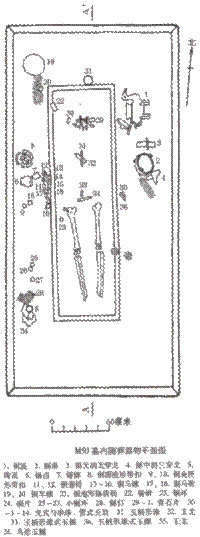
The tomb M50 was adjacent to the tomb of the King of Ying State. With the study of this he vessel, archaeologists believed that the tomb occupant was a Sishi or the court official in charge of foreign affairs of the Ying State during the era under King Mu of Zhou. The tomb owner was named Pu.
Bird- and beast-shaped wine vessels occupied a large category of bronzes in shapes of living creatures and usually known to the academic circles as bird- or beast-shaped zun vessels. Bird- and beast-shaped potteries were made as early as in the Neolithic Age.
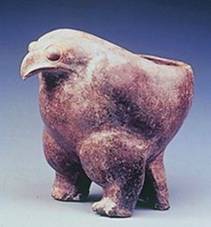
Eagle-shaped pottery zun vessel in the collection of the National Museum of China
The pottery eagle-shaped zun, made of black-pottery clay, is 36 centimeters high. A round hole on the back of the standing eagle serves as the vessel mouth. It is now in the collection of National Museum of China.
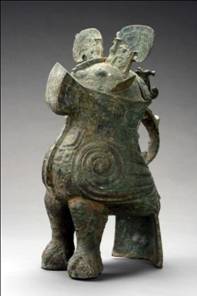
Owl-shaped zun vessel in the collection of Henan Museum
The owl-shaped zun was unearthed from Lady Fuhao’s Tomb in the Yin Ruins, Anyang, in 1976. The 46-centimeter-high vessel, shaped like an owl, looks quite elegant and exquisite.
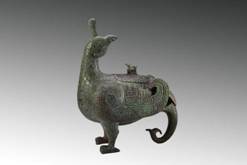
Bird-shaped zun vessel in the collection of Shanxi Museum
The bird-shaped zun vessel of Marquis of Jin of the early Western Zhou Dynasty [5] measures 39 centimeters in overall height and 30.5 centimeters in length. It was unearthed from M114 of Tombs of Marquis of Jin in the Beizhao Village, Quwo County, Shanxi Province. The tomb occupant was Xiefu, the first Marquis of Jin. The vessel is in the shape of a lifelike phoenix looking back. The design smartly integrates practical function with artistic beauty.
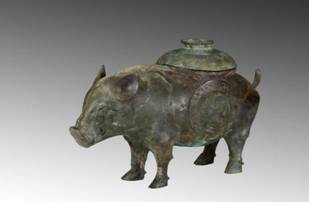
Pig-shaped zun vessel in the collection of Shanxi Museum
The pig-shaped bronze zun vessel of the Western Zhou Dynasty measures 22.4 centimeters in overall height and 39 centimeters in overall length. It was unearthed in 2000 from M113 of Tombs of Marquis of Jin in the Beizhao Village, Quwo County, Shanxi Province. The tomb occupant was wife of Xiefu, the first Marquis of Jin.
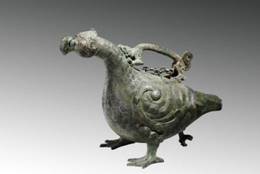
Bird-shaped zun vessel in the collection of Shanxi Museum
This bird-shaped bronze zun vessel of the Spring and Autumn Period was unearthed in 1988 from Zhao Qing’s tomb in the Jinsheng Village, Taiyuan, Shanxi Province. The vessel is in the shape of a large raptor, decorated with rich patterns.
Among all the unearthed bird- and beast-shaped bronze zun vessels, the earliest were the owl- and ox-shaped ones dating from the early phase of the Yin Ruins. As the owl-shaped zun vessel was of delicate craftsmanship, bronzes of the kind must have been cast before it. Archaeological circles are expecting the bird- and beast-shaped bronze zun vessels of an earlier period to be discovered. By the late phase of the Yin Ruins, bird- and beast-shaped zun vessels had seen further development, with more shapes emerging, such as ox, rhinoceros, goat, pig and elephant. The Western Zhou Dynasty saw the zenith of the manufacturing of bird- and beast-shaped zun vessels. The vessels were produced in large numbers and varieties, with new shapes emerging, including hare and mandarin duck. Bird- and beast-shaped bronze zun vessels were on decline in number and variety during the Spring and Autumn and the Warring States Periods.
Could you make a guess why this bronze he vessel was cast in the shape of a wild goose?
Your answer please, if you have any questions or answer, please feel free to send us email, we are waiting for your answers and participation, and your comments, answers and suggestions will be highly appreciated. We will select and publicize the most appropriate answers and comments some time in the future.
Weekly Selection Email: meizhouyipin@chnmus.net
The people of Ying State were the descendants of the Yinglong Tribe. Ying (“应”) was a pictographic character of “鹰” (eagle) in the inscriptions on tortoise shells or animals’ bones, indicating that the Ying people had bird as their totem. During the Shang Dynasty, the descendants of the Yinglong Tribe established Ying State in the Zhangzi County, Shanxi Province, with the capital city in Ying. Ying State was an important vassal state on the western border of the Shang Dynasty. After Zhou eliminated the Shang court, Yingshu, a son of King Wu of Zhou, was granted with Ying State as his fiefdom. The ancient Ying State then became a vassal state of Zhou under the reign of Ji Family. The Ying people later migrated southwards and established a new capital in the area around present-day Pingdingshan, Henan Province. But they kept the old name of their state. Chu State attacked and seized Ying State around 680BC. King Ping of Chu ascended the throne in 528BC and launched a nationwide resurrection campaign in Chu State. Ying State then became a shield of strategic importance on the northern border of Chu State and played a significant role in defending the northern territory of Chu. Around 300BC, Ying State was finally annexed by Qin State and given by the King of Qin to a court official named Fan Ju as his manor. Fan was accordingly known as Marquis of Ying. By then, the ancient Ying State was officially ended as a vassal state and faded into history.
The cemetery of Ying State discovered in Pingdingshan was the family graveyard of Marquis of Ying. Those buried there were mostly nobles of the Western and Eastern Zhou dynasties. Starting from the early Western Zhou Dynasty, the cemetery had been in use through the Western Zhou Dynasty, the Spring and Autumn Period, the Warring States Period, the Western Han Dynasty to the Eastern Han Dynasty when the site was abandoned. However, some tombs of the Tang and Qing dynasties were also discovered in the site. Over 80 tombs of the Western and Eastern Zhou dynasties and more than 400 tombs of the Han Dynasty and other periods have been discovered by now, with large numbers of exquisite bronze ritual vessels and jade wares unearthed. This archaeological discovery is of great importance to studies of the history of Ying State and provides new first-hand materials on the history of the Western Zhou Dynasty and on the relationships between vassal states such as Ying, Chu, Deng and Zuo.
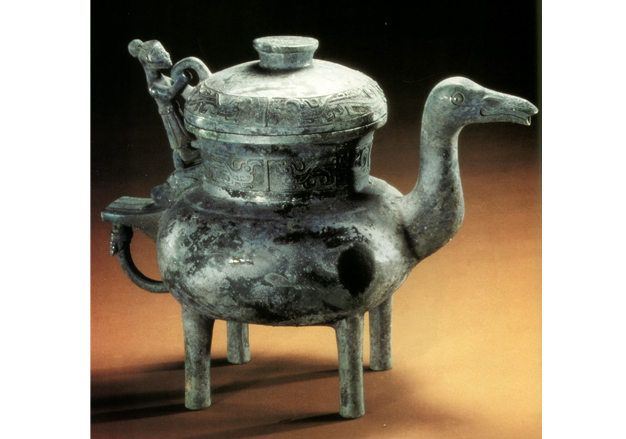
The Pu’s wild-goose-shaped bronze he [1] was a wine vessel of the Western Zhou Dynasty. It measures 25.2 centimeters in overall height, 31.8 centimeters long from the spout to the tail, 17.2 centimeters in body width and 14.3 centimeters in mouth diameter. This 3,550-gram vessel has a volume of 2,125 milliliters. It was unearthed in 1988 from Ying State cemetery in Pingdingshan, Henan Province. It is now in the collection of Henan Museum.